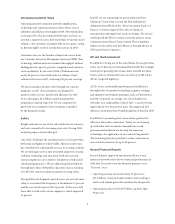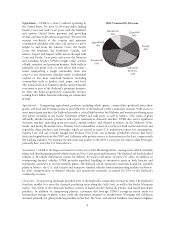Union Pacific 2006 Annual Report Download - page 11
Download and view the complete annual report
Please find page 11 of the 2006 Union Pacific annual report below. You can navigate through the pages in the report by either clicking on the pages listed below, or by using the keyword search tool below to find specific information within the annual report.primarily in the Gulf Coast region, as well as the West and Canada, bound for major agricultural users in the
Midwest and the western U.S.
Energy – Coal transportation accounted for 20% of the Railroad’s 2006 commodity revenue. The Railroad’s
geographic network allows it to transport coal destined for utilities and industrial facilities in 27 states, as well as
to the Gulf and rail/barge/ship facilities on the Mississippi and Ohio Rivers and the Great Lakes. UPRR serves
mines located in the Southern Powder River Basin of Wyoming (SPRB), Colorado, Utah, southern Wyoming, and
southern Illinois. SPRB coal represents the largest growth segment of the market, as utilities continue to favor its
lower cost and low-sulfur content.
Industrial Products – The Railroad’s extensive network enables the industrial products group to move numerous
commodities between thousands of origin and destination points throughout North America. Lumber shipments
originate primarily in the PNW and Canada for destinations throughout the United States for new home
construction and repair and remodeling. Commercial and highway construction drives shipments of steel and
construction products, consisting of rock, cement, and roofing materials. Paper and consumer goods, including
furniture and appliances, are shipped to major metropolitan areas for consumers. Nonferrous metals and
industrial minerals are moved for industrial manufacturing. In addition, the Railroad provides efficient and safe
transportation for government entities and waste companies. In 2006, transporting industrial products provided
21% of the Railroad’s commodity revenue.
Intermodal – UPRR’s intermodal business, which represented 19% of the Railroad’s 2006 commodity revenue,
includes international, domestic, and premium shipments. International business consists of imported container
traffic that arrives at West Coast ports via steamship for destinations throughout the United States. Domestic
business includes domestic container and trailer traffic for intermodal marketing companies (primarily shipper
agents and consolidators) and truckload carriers. Less-than-truckload and package carriers with time-sensitive
business requirements account for the majority of our premium service.
Working Capital – We currently have, and historically have had, a working capital deficit, which is common in
our industry and does not indicate a lack of liquidity or financial stability. We maintain adequate resources to
meet our daily cash requirements, and we have sufficient financial capacity to satisfy our current liabilities.
Competition – We are subject to competition from other railroads, motor carriers, and barge operators. Our
main rail competitor is Burlington Northern Santa Fe Corporation. Its rail subsidiary, BNSF Railway Company
(BNSF), operates parallel routes in many of our main traffic corridors. In addition, we operate in corridors served
by other railroads and motor carriers. Motor carrier competition is particularly strong for five of our six
commodity groups. Because of the proximity of our routes to major inland and Gulf Coast waterways, barge
competition can be particularly effective, especially for grain and bulk commodities. In addition to price
competition, we face competition with respect to transit times and quality and reliability of service. While we
must build or acquire and maintain our rail system, trucks and barges are able to use public rights-of-way
maintained by public entities. Any future improvements or expenditures materially increasing the quality or
reducing the costs of these alternative modes of transportation, or legislation releasing motor carriers from their
size or weight limitations, could have a material adverse effect on our results of operations, financial condition,
and liquidity.
Equipment Suppliers – We depend on two key domestic suppliers of locomotives. Due to the capital intensive
nature and sophistication of this equipment, high barriers to entry face potential new suppliers. Therefore, if one
of these domestic suppliers discontinues manufacturing locomotives, we could experience a significant cost
increase and risk reduced availability of the locomotives that are necessary to our operations.
Employees – Approximately 87% of our 50,739 full-time-equivalent employees are represented by 14 major rail
unions. In January 2005, we began the current round of negotiations with the unions. Existing agreements remain
in effect and will continue to remain in effect until new agreements are reached or the Railway Labor Act’s
5
























